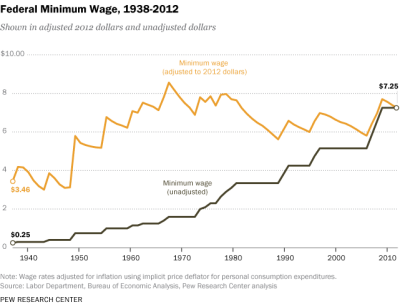
In prior posts on my Freestater blog, I’ve argued against proposals in Maryland to raise the minimum wage to $10.10 per hour on the grounds that it will do significant damage to the employment prospects of young and unskilled workers — and not provide much actual help to the working poor.
What I’ve not made clear is that I do not oppose raising the minimum wage. In fact, I think a review of the history of the wage suggests that it should be raised to approximately $8.40 an hour and then indexed to inflation thereafter. But the proposal to make Maryland’s minimum $10.10 by 2016 simply goes too far and would likely have significant negative effects on youth and unskilled employment levels.
Those advocating the $10.10 an hour wage like to claim that had the minimum wage in the late 1960s simply kept pace with inflation the wage today would be well be roughly $10.50 per hour. Unfortunately, those folks are being intentionally misleading.
Misleading figures
The adjacent graph, courtesy of the unbiased folks at Pew Research Center, shows that the period from the late 1960s through at least 1981 were an unusually “generous” period for the minimum wage. But the period was far from the norm. Minimum Wage Graph Pew CenterIf one were to select the late 1940s or the late 1950s as the basis for today’s wage in would be far below $10.50, below $10.10, and below the current level of $7.25, so claims of an inflation adjusted $10 minimum wage are simply disingenuous.
The other justification for the $10.10 per hour proposal is that it would raise the income of a family of four, with a single parent working full time, to the poverty level. But this a dubious goal. The average family size in American is 2.6, not 4, and more importantly, less than 1/3 low income families are headed by a single adult. So neither of the main arguments for a $10 wage hold up to serious scrutiny.
The case to be made for raising to $8.40
That said, there is a case to be made that the inflation-adjusted average wage for the “generous” period should serve as a baseline for the wage moving forward. Without question, a concerted effort was made to increase the purchasing power of the minimum wage throughout the 1960s and 70s before a long slide began in the 1980s through until 2009.
Boosting the wage to the 1960s and 70s level would yield a minimum wage for 2015 of approximately $8.40 per hour. If it were then indexed to inflation and automatically adjusted every year thereafter it would no longer go through long periods of decline followed by sudden increases. As result, it would provided some degree of predictability in the value of the wage to workers and the cost of labor to employers.
A potential jump in unemployment
In a prior post I cited a New York study that estimated a 20% jump in job loss among the young and the unskilled as a result of a 30% hike in the state’s minimum wage. Applying those findings to Baltimore City, where unemployment among those aged 16-24 is a devastating 31%, could lead to an unimaginable 37.5% unemployment rate.
Beyond Baltimore City youth, the overall unemployment rates in Baltimore City, Washington County in western Maryland, and the counties of the lower Eastern Shore show that significant portions of the state simply could not absorb the job shock likely to be caused by a 40% wage hike.
The governor and the folks at Raise the Wage estimate that over 500,000 workers would get a raise if the minimum were set at $10.10. With just under 3 million employed workers in the state that amounts to nearly 17%! That represents a significant new cost imposed upon businesses.
How can anyone seriously think that employers will not respond by trimming hours, cutting positions, and refusing to hire the young and the less skilled? How can anyone believe that the state’s high unemployment counties will be made better off?
Senate President Mike Miller has been less than receptive to the idea of a $10.10 statewide minimum. He has raised the possibility of allowing counties to set their own wages. Though that is certainly preferable to a statewide minimum of $10.10 per hour, I think a wage of $8.40 per hour, adjusted for inflation thereafter, is the best option for the state (and the country).
Todd Eberly is associate professor of political science and Coordinator of Public Policy Studies at St. Mary’s College of Maryland. He is currently on sabbatical writing a book.

